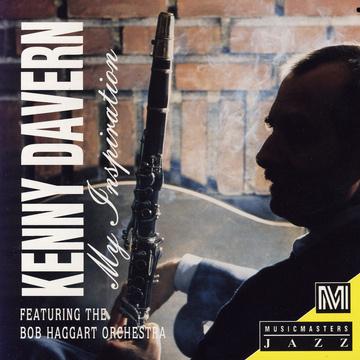

KENNY DAVERN: MY INSPIRATION
FEATURING THE BOB HAGGART ORCHESTRA
[1] My Inspiration
(Bob Haggart, Hilton Nappy Lamare)
Bregman Vocco & Conn Inc.
[2] It Had To Be You
(Isham Jones, Gus Kahn)
Remick Music Corp.
[3] Then You've Never Been Blue
(Ted Fiorito/Lewis & Young)
Remick Music Corp.
[4] Dogtown Blues
(Bob Haggart)
EMI Fiest Catalog Inc.
[5] Georgia On My Mind
(Stuart Gorrell, Heagy Carmichael)
Hoagland Music, Peer Music
[6] Farewell Blues
(Paul Joseph Mares, Elmer Schoebel)
Mills Music Inc., Edwin H. Morris & Co., Inc.
[7] Brother, Can You Spare A Dime?
(Jay Gomey, E.Y. Harburg)
Harms, Inc.
[8] Spreadin' Knowledge Around (Harry James, Ben Pollack)
[9] What's New?
(Johnny Burke, Bob Haggart)
Limerick Music Corp./Marke Music Pub. Co., Incl
M. Wrtmark & Sons
[10] She's Funny That Way
(Richard A. Whiting, Neil Moret)
Chappell & Co., Inc.
[11] Should I?
(Nacio Herb Brown, Arthur Freed)
Robbins Music Corp.
[12] Summertime
(George Gershwin, Ira Gershwin, Du Bose Heyward)
Chappell & Co./Gershwin Pub. Corp.
[13] I'm Confessin' (A.J. Neiburg, Doc Dougherty, Ellis Reynolds) Bourne Co.
[14] Travelin' All Alone
(J.C. Johnson)
Record Music Publishing Co.
[15] Sweet Lorraine
(Clifford R. Burwell, Mitchell Parish)
Mills Music Inc.
[16] Embraceable You
(George Gershwin, Ira Gershwin)
New World Music Corp.
ALL ARRANGEMENTS BY BOB HAGGART
PERSONNEL:
Kenny Davern. Clarinet; Howard Alden,* Guitar; Bobby Rosengarden. Drums; Bob Haggart. Bass/Leader; Lamar Alsop. Raymond Kunicki. Sanford Allen, Elliot Rosoff, Violins I; Yuri Vodovoz. Byung Kook Kwak. Eric DeGiola, Violins 2; Manny Vardi. Alfred Brown. Violas; Kermit Moore. Ann Callahan. Cellos; Alan Raph. Contractor
*Howard Alden appears courtesy of Concord Records
For Haggart, as for Davern, the chance to team up on a clarinet-with-strings session was a dream come true. Incredible as it seems, the composer and arranger of such standards as "South Rampart Street Parade," "What's New?", "My Inspiration" and "Big Noise From Winnetka" had never before. written a whole album for strings. "The idea for this project came about two or three years ago when Kenny and I were working together in the World's Greatest Jazz Band," Haggart recalls. "It occurred to me that his beautiful, limpid sound would go so well with a string backing, and I told him so. He said, 'Great idea! You 'll do the arrangements."'
Haggart eagerly took up the challenge. He had long since earned his place in the Pantheon of jazz greats, as a member of Bob Crosby's Bobcats from 1935 to 1942, as a sideman with Louis Armstrong, Billie Holiday and Duke Ellington, and as a cofounder with Yank Lawson of the World's Greatest Jazz Band in 1968. But here was a chance for him to break new ground. "I hadn't been writing in quite a while," he says. "I got some score paper and threw myself into it. I loved it.
The New York Times recently called Kenny Davern "probably the finest clarinetist playing today." If anything, that's an understatement. Kenny is a clarinet player's clarinet player. Since Benny Goodman disappeared from the scene, Kenny has had no peer in the swingmainstream mode. By almost any standard -tone, intonation, lyricism, invention, taste, feeling -- he is in a class by himself, and has a distinguished body of recordings to prove it. So what makes this album special? Simple: a consummate clarinetist has teamed up with one of the greatest living jazz arrangers, bassist Bob Haggart, to create an irresistible feast of melody, tone and texture. "It's every horn player's dream to hear himself with a lush bed of strings," says Kenny. "These are melodies and songs that live forever. For me, the message of this session is this: here is music played with love; charts, melodies, arrangements written with love, and performed with feeling."
I didn't realize how much I missed writing."
Davern had given his arranger a list of tunes -mostly standard ballads with a handful of Haggart compositions thrown in -- and Haggart worked up the songs that struck his fancy. The process took up two full years. "I made a lot of changes and had second thoughts," Haggart recalls. "Sometimes, in my condo in Venice, Florida, I would get up in the middle of the night and work parts out on the piano. In California, where I did most of the writing, I couldn't play at night, so I had to pick and choose my work times."
Sometimes the writing had to be squeezed in between road gigs with the World's Greatest Jazz Band. Davern recalls being on tour with the WGJB last spring and seeing Haggart scribbling away on the charts in his hotel room. "He'd put a check mark on the arrangements every time he changed something. He's such an incredible perfectionist." Finally, the arrangements were ready. About one week before the recording session, they were sent separately to Davern and to the string players. Kenny worked over his parts with guitarist Howard Alden, whom he calls his regular "sparring partner." But there was no chance to rehearse the whole ensemble before the 12 string players joined the jazz
quartet of Davern, Haggart, Alden and drummer Bobby Rosengarden in BMG's Studio A on West 44th Street.
The normal way of recording such sessions is for the strings to lay down their backing tracks with the soloist coming in later to overdub. Kenny would have none of it. "I said, 'no way,"' he recalls. "I wanted that spontaneous feeling -- no partitions, no gimmickry." That meant that the session had to be done all in one day. It was chancy, but that was the way Kenny wanted it.
The tapes started turning at 1 p.m. on "Summertime," a Gershwin composition that Kenny has personalized to the point where bassist Milt Hinton now tells him, with only slight exaggeration, "You own that tune, man, you own that tune." While producer Gregg Squires and engineer Paul Goodman finetuned the balance, Kenny blew two or three renditions. Then he turned to the string players with a big smile and applauded their work. "They had a big sound," he said later, "They're the best in New York."
After working over the first number, Davern and Haggart came into the control booth to sample the mix. Kenny, ever the perfectionist, seemed enchanted with the sound -- but something was wrong. He told guitarist Alden to plug in his amplifier and go electric. "It gave
him more of a presence," says Davern, "made him more of a partner than an accompanist. In many respects Howard is the star of the album. I couldn't be blowing all the time. Sometimes, I had to give him the lead because I was too tired to do it any more."
Not surprising that he got tired. The session lasted from 1 to 5 p.m., with a break for dinner, then continued from 7 to 11 p.m. At that point, the string players left and the quartet put another four tunes in the can over the next 45 minutes.
As they walked out of the studio around midnight, Davern turned to Haggart and asked, "What do you think, Hag?" Haggart's reply: "It was better than my wildest expectations."
For Haggart and Davern, the session was well worth the wait. "It's made me want to start writing seriously for strings," says Haggart. "Maybe broaden things out a little. Do something a bit more modern. But we'll see. I'm basically a lazy guy -- I like to paint and play golf and spend time with my wife." At 77, after such a distinguished career, who can blame him?
As for Kenny, he sees this session as a pivotal moment in a professional career that goes back to his high school days in Queens, NY in the early 50s. Kenny has paid his dues as a jazzman, working alongside such legends as
Jack Teagarden, Red Allen, Buck Clayton, Jo Jones and Eddie Condon. Since the mid-70s, when he teamed up with Bob Wilber to form the memorable Soprano Summit, he has emerged as a major solo voice, working mainly in trio and quartet settings. It is a demanding role for a clarinetist, but one that a musician with Kenny's extraordinary range and supple technique always manages to make exciting. Now he feels that recording with strings would be a stepping stone to new performing opportunities. "This could lead me into a different direction," he says. "If there is a modicum of success with this album, I could wind up playing pops concert series, with the quartet backed up by a full string section."
But wouldn't a jazzman be compromising himself in such a setting? Kenny bristles at the notion. "It is every player's dream to perform with strings," he says. "Charlie Parker always said his string sessions were his favorite recordings, yet he was accused of selling out. Is it commercial to record with strings? You're damn right. But why make any recording if it's not to sell it?"
The music on this album transcends such debates. Everyone from the jazz purist to the casual listener will find something to cherish on these sides. As Haggart put it when asked if his two years of labor were worth it: "The payoff is hearing it."

